
Astronomers have discovered a supernova exhibiting un...
Read More

Astronomers have discovered a supernova exhibiting un...
Read More
ALMA revealed the rotation of the torus very clearly for the first time. Credit: ALMA (ESO/NAOJ/NRAO)
High resolution observations show a rotating dusty gas torus around an active supermassive black hole. The existence of such rotating donuts-shape structures was first suggested decades ago, but this is the first time one has been confirmed so clearly. This is an important step in understanding the co-evolution of supermassive black holes and their host galaxies.
Researchers have known for a long time that the more massive the galaxy is, the more massive the central black hole is. This sounds reasonable at first, but host galaxies are 10 billion times bigger than the central black holes; it should be difficult for two objects of such vastly different scales to directly affect each other...
Read More
Recent Comments